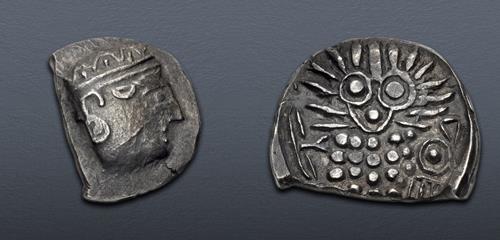|
ARABIA, Southern. Ma'in (Minaia)(?). Circa 250-150 BC. AR BLṬT – “Tetradrachm” (27mm, 15.14 g, 9h). Imitating Athens. Stylized helmeted head of Athena right / Owl standing right, wings folded; stylized olive spray and crescent to left, ƎΘΔ downward to right. Huth 158 = M. Huth, “The ‘folded flan’ coinage of eastern Arabia: some preliminary comments” in Arabian Archaeology and Epigraphy 9 (1998), 5 (this coin); M. Huth, “Monetary Circulation in South West Arabia” in CCK, p. 85, I. Toned, struck on a folded flan, minor die break on obverse, some minor scratches. EF. Extremely rare.
From the Jonathan Kagan Collection.
This fascinating coin of derivative Athenian type was struck on a folded flan of another coin, and was originally attributed by Huth (1998) to a mint in eastern Arabia, where all of the six then-extant examples had been found. The discovery of the al-Jawf hoard in 2002, however, definitively changed his view of this intriguing coinage. In his analysis of the hoard (in CCK), Huth determined that all of the previous six coins, and those found in the hoard, were struck from the same mint, in three phases that employed increasingly simplified methods. In the first phase, the coins were struck on previous tetradrachms that were folded over twice, forming a triangular shaped flan upon which derivative Athenian types were struck. The second phase consisted of coins struck on previous coins that had only been folded over once, forming a semicircular shaped flan (the present coin is the only known example from this phase). Finally, in the third phase, the host tetradrachms were cut into two halves that were then each folded once, then both halves were placed upon each other and joined by hammering, resulting in a triangular shape. The identification of the undertype used for this series in uncertain. While Huth originally surmised that Alexanders were the common host coin, his analyis of the al-Jawf hoard suggested that this was not likely. Though the question of the undertype remains unresolved, the hoard provided strong evidence that this series was not of eastern Arabian origin, but rather from a mint in the region of Wadi al-Jawf, in the Minaian trading sphere.
The final winners of all Triton XXVI lots will be determined at the live public sale that will be held on 10-11 January 2023.
Triton XXVI – Session Two – Lot 335-673 will be held Tuesday afternoon, 10 January 2023 beginning at 2:00 PM ET.
Winning bids are subject to a 22.5% buyer's fee for bids placed on this website and 25% for all others.
We recognize that our users may have various Internet Browsers and Operating Systems. We like our visitors to have the best possible experience when using our bidding platform. However, we do recognize that it is impossible to develop applications that work identically, efficiently and effectively on all web browsers. The CNG bidding platform supports the latest stable major version and stable previous version of Chrome and Firefox.
|
